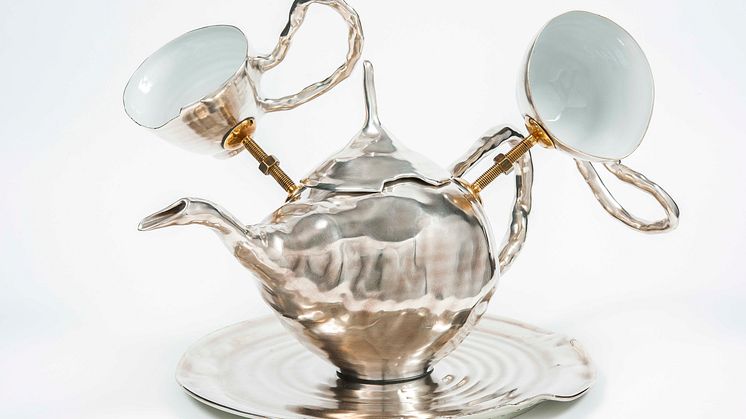
Press release -
New acquisition: Teapot by Ivan Jelinek
Nationalmuseum
has added an exciting piece by Czech ceramicist Ivan Jelinek to its collection
of contemporary applied art. The new acquisition is a large ceramic teapot
inspired by the Mad Hatter’s tea party in Alice
in Wonderland. With its curvaceous lines and highly imaginative design, the
piece is typical of the artist’s distinctive work.
The TERRA exhibition at Stockholm’s Blås & Knåda gallery earlier this year brought a breath of fresh air from continental Europe in the form of eight ceramic artists from four countries associated with Gallerie Terra Delft in the Netherlands. What they all have in common is that their work is inspired by 18th-century figurines, yet has an undeniably contemporary look. The expression is more externalized and fantasy-inspired, generating a stronger sense of surprise, derision and shock.
One of the pieces from the exhibition has now been added to Nationalmuseum’s collection: a large ceramic teapot, inspired by the Mad Hatter’s tea party in Alice in Wonderland. The curvaceous pot, which is orbited by two teacups, sits on a large dish. The ceramic surface is coated in a glaze containing silver. Two coats of glaze were applied by brush, and the piece was fired after each coat.
The artist, Ivan Jelinek, was born in 1951 in Prague, where he also trained. He is widely known in Europe for his ceramic vessels, which all have distinct personalities and curving lines, creating an integral sense of movement. It is almost as though they are expressing human emotions through their form.
This somewhat impractical teapot clearly shows that applied art is still art, a point that we sometimes fail to appreciate when looking at other, “fit-for-purpose” ceramic teapots. The visual appearance of this piece appeals to our emotions and our imagination to an especially high degree.
The teapot has been donated to Nationalmuseum’s applied art and design collection by the Bengt Julin Fund, part of the Friends of Nationalmuseum. Nationalmuseum has no budget of its own for new acquisitions, but relies on gifting and financial support from private funds and foundations to enhance its collections of fine art and craft.
Further information
Micael
Ernstell, curator applied art and modern design, micael.ernstell@nationalmuseum.se +46 8 5195 4392
Hanna Tottmar, Press Officer, hanna.tottmar@nationalmuseum.se, +46 767 23 46 32
Caption
Ivan Jelinek, Teapot. Photo: Anna
Danielsson/Nationalmuseum.
Categories
Nationalmuseum is Sweden’s premier museum of art and design. The collections comprise older paintings, sculpture, drawings and graphic art, and applied art and design up to the present day. The museum building is currently under renovation and scheduled to open again in 2017. In the meantime, the museum will continue its activities through collaborations, touring exhibitions and a temporary venue at the Royal Swedish Academy of Fine Arts, Fredsgatan 12, Stockholm. Nationalmuseum collaborates with Svenska Dagbladet, FCB Fältman & Malmén and Grand Hôtel Stockholm. For more information visit www.nationalmuseum.se.

